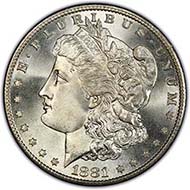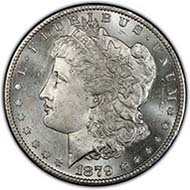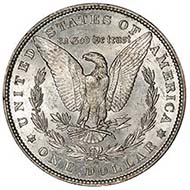Recently, they are found in an increasing number at German auctions. Coins which are consigned not as simple coins but are shrink wrapped in a small plastic box – called “slab” by experts. To some that is a nuisance (how to place such a slab in a BEBA box?), to others a pleasure because of the safe storage and the guarantee offered by an independent inspection.
What good is the grading service for?
Currently, there are four leading grading companies in the USA – ANACS, ICG, PCGS and NGC (that list does not imply a valuation but is merely compiled in alphabetical order). They brought the system that was common in Europe until then to perfection with a distinction of roughly 70 grades (1 for poor, 70 for perfect) of which approximately 30 are de facto applied.
For the grading of an “ordinary” coin roughly $ 10 to 50 must be paid – the lower price categories are reserved for Modern coins from the second half of the 20th century. Rarities may cost more than $ 500.
The customer who entrusts his coins to a grading service gets an expert description of the state of preservation and an authentication. The description is given by a person with no financial or personal interest in the piece, hence by one who is unbiased. The seller’s information is checked, and the buyer can rest assured about the description of his acquisition. As another piece of service the grading service provides the “slab”, i.e. the small container in which the coin is stored from then on and that was made especially for that purpose. In that container the coin is protected from damages like scratches and edge bumps, and likewise the patina is secure.
Problems of the grading
The grading’s main problem is the human factor. Since the coin is welded in the slab any further detailed inspection is rendered impossible unless the slab is broken. Hence, everything depends on the knowledge of the person entrusted with the inspection. And there is only limited time to ascertain the grade of a coin and its authenticity.
Any accurate determination of the grade by the human eye – even with machine manufactured coins whose style and mintage are immaterial – hinges on the describer’s form of the day. Yesterday’s “good very fine” may well be “about extremely fine” today. That holds true already for the small range of variety of the European system! How much more prone – so say the critics – must be a system of fine and ultra-fine grades? US American coin dealers report that colleagues consigned a coin to be graded again and again until it was awarded the desired grade. The grading’s cost notwithstanding that can be a lucrative business since in the USA the prices for the different grades very considerably.
A study conducted by Coin World in 2003 points in the same direction. In that four year study, Coin World undercover consigned identical coins to the four most important grading companies and, in addition, had them graded by an independent expert. The result was that “in no case did the grading services agree on the grade of any given coin, and in some cases the difference in grading was as much as seven points off”.
Transparency and consistency
Of course, the grading companies are aware of that problem, too. Muriel Eymery, head of the European branch of PCGS, explained, which measures PCGS has developed in order to guarantee transparency and consistency. She explained that every coin is anonymized at the beginning of the process. Then it will be sent to two independent graders. The graders won’t know, who will be the other one to evaluate the grade of the coin. If the two graders disagree concerning the grade, indeed, if there is only one grade difference in their opinion, a chief grader will have a look at it and provide his grade too. If still after this 3rd assesment, the experts differ on the final grade, at the end of the day all graders will have a look at this coin in order to find a common decision.
Ms. Eymery stressed that every grader will be evaluated on a weekly and on a monthly basis to keep PCGS grading consistency and accuracy over time.
She also reacted to the study of Coin World. She compared the slight differences in grading with school grades: The grade of a school with a good reputation is worth much more than a better grade from an unknown school – every potential employer knows how to interpret the skills of an applicant using marks from different schools.
Computerized grading?
Of course, the grading companies are aware of that problem, too. But the human eye is still superior to any computer regardless of the US American patent no. 4899392 issued on February 6th, 1990, protecting a computerized system for “objective” grading. It should read “aimed at protecting” since between the patent holder and the management of the collecting society Compugrad a disagreement arose leading the inventor to publish a letter. There he stated the names of a number of numismatists who had not officially waived their intellectual achievements in inventing the system. The patent therefore was forfeited, and Compugrad did not own the utilization rights exclusively anymore and gave in the year the company had been set up.
The issue of cleaned coins
Anyone concerned with counterfeits knows how hard it can be to tell right from wrong accurately and comprehensibly when be pressed for time. Even more so when – as is often done in Europe – a coin is (heavily) cleaned. That is why some companies refuse to grade such coins – even though an inspection might prove their authenticity.
In Europe, that could become a problem because coins from old collections are often cleaned.
A question of knowledge and trust
Especially for those who have recently started coin collecting it may be wise to take use of a grading service to avoid big mistakes when buying a coin. Those who regard coins as an investment may feel reassured by another, unbiased opinion about the piece in question. Grading services live on the mistrust a buyer has of a seller and his financial interest.
With a grading service a customer can be sure that a qualified expert deals with his coin for a certain time. That expert naturally is not infallible – like every human being, every dealer and every collector.
Developments
In the United States of America coin slabbing for Modern coins has become common practice nonetheless. The American coinage being relatively manageable enables the grading services to be relatively reliable in their grading. The grades are much more important for US American coins than for European ones. At present, the American grading services move into the European market. PCGS has opened an office in Paris so that consigned coins do not have to be sent to the USA anymore but stay within the EU.
Curiosities
It has become impossible to imagine the American coin fairs without the slab. To the buyer, it reflects a security that is even exploited by forgers today. They produce counterfeit coins in counterfeit slabs that enjoy great popularity especially in unchecked internet auctions.
Of course, some American collectors even begin to dismiss the coins in favor of the slabs. So far, 80 companies issued roughly 200 slab varieties. There are of course a catalog and a specialized website extant. If you are fed up with coins and think of collecting slabs instead have a look at: http://www.sampleslabs.com/
The system
Here, you have the opportunity to see for yourself the grading’s system. The pictures were kindly provided by PCGS. At http://www.pcgs.com/Photograde/ you will find more examples. We chose the Morgan Dollar – minted 1878-1921 – to show how a coin must look like if to be awarded a certain grade.
Virtually as struck with minuscule imperfections, near full strike necessary.
Virtually as struck with slight imperfections, slightest weakness of strike allowed.
Virtually as struck with minor imperfections, very well struck.
Few minar marks / hairlines not in focal areas, good strike.
Minor marks / hairlines through none in focal areas, above average strike.
Few marks / hairlines or a couple of severe ones, strikes should be average or above.
Moderate number / size marks / hairlines, strike may not be full.
No wear. Slightly less marks / hairlines, strike may not be full.
No wear. Multiple heavy marks / hairlines, strike may not be full.
No wear. May have many heavy marks / hairlines, strike may not be full.
Full detail with only slight friction on the high points.
Full detail with friction on less than 1/2 surface, mainly on high points.
Full detail with friction over 1/2 or more of surface, very slight flatness or high points.
Full detail with friction over most of the surface, slight flatness on high points.
Detail is complete with most high points slightly flat.
Detail is complete but worn with high points flat.
Almost complete detail with flat areas.
Slightly more definition in the detail and lettering.
Some definition of detail, all lettering full and sharp.
Slightly more detail in the recessed areas, all lettering sharp.
Some deeply recessed areas with detail, all lettering sharp.
Design worn with slight detail, slightly clearer.
Design worn with slight detail.
Rims complete with flat detail, peripheral lettering full.
Slightly worn rims, flat detail, peripheral lettering nearly full.
Worn rims but most lettering is readable though worn.
Mostly worn, though some detail is visible.
Mostly worn, though some detail is visible
Identifiable date and type.































































